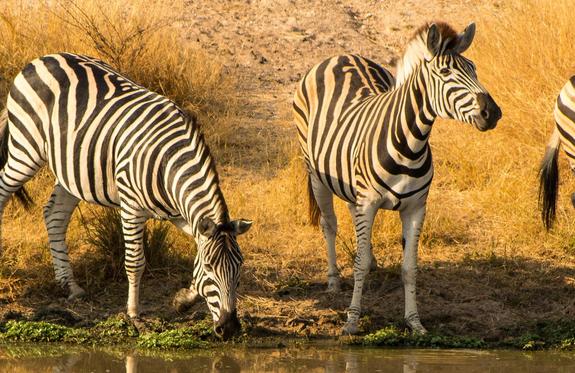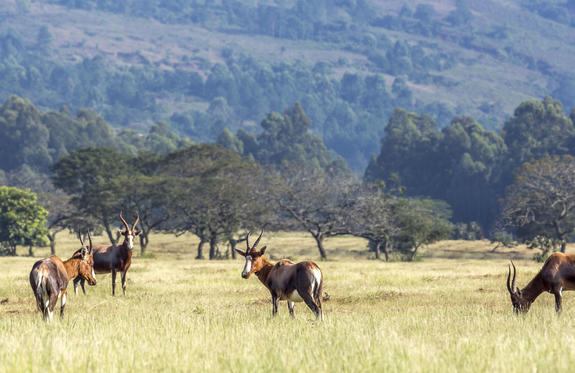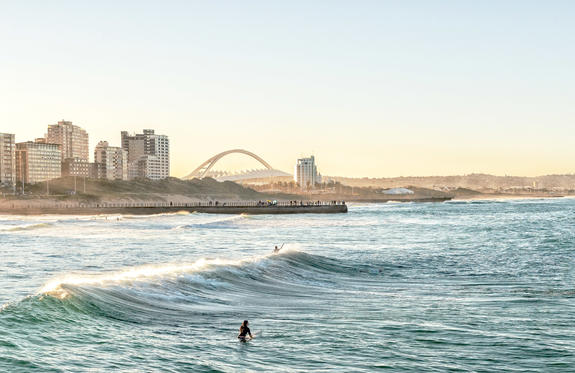South Africa is a fascinating and diverse travel destination, and its slogan, "A World in One Country," truly reflects reality.
The "New South Africa" has eleven official languages. In addition to Afrikaans, English is the official language. The following indigenous languages are also spoken, listed in alphabetical order: Ndebele, North and South Sotho, Swati, Tsonga, Tswana, Venda, Xhosa, Zulu.
The transition to democracy, following the state elections in April 1994 in a country with over 56 million inhabitants, proceeded relatively peacefully.
South Africa is a highly diverse country where various cultures, religions, and ethnicities coexist, mostly in a respectful manner. The population is exceptionally friendly and helpful, eager to engage in contact and conversation with visitors to their country.
The country is three times the size of Germany (approximately 1.22 million km²) and is divided into nine provinces. It offers a variety of geographical and climatic zones, from the semi-desert Karoo to the lush subtropical Natal coast, from the Mediterranean climate of the Cape to the "Bush" in eastern Mpumalanga, formerly Transvaal. Explore and experience the magnificent blend of breathtaking landscapes: the mountainous regions perfect for hiking, vast wildlife reserves and conservation areas like Kruger National Park and Hluhluwe-Imfolozi Game Reserve, endless pristine beaches, modern cities, and sunshine 365 days a year, as somewhere in South Africa, the sun shines every day!
The different climate zones and the vastness of the country offer a variety of sports activities, such as horseback riding, surfing, hiking, canoeing, swimming, or golfing.
Many visitors "fall in love" with South Africa and return repeatedly to enjoy their holidays here and embark on new adventures. A major advantage is that there is no time difference (only one hour during the switch to daylight saving time/winter time), resulting in no jet lag.
Please keep in mind that unforeseen or unexpected situations may arise during your trip to South Africa. Flexibility, patience, and openness are always good companions and often the key to a wonderful journey.

The relatively small town of Hoedspruit translates directly from Afrikaans to "Hat Creek" and is an authentic and culturally rich South African village on the border of Limpopo Province, at the foot of the Klein Drakensberg Mountains.
The village offers a variety of leisure activities and even has its own airport. Additionally, there are numerous modern facilities here, such as a tourist information center, two large grocery stores, gas stations, several restaurants, and some nightlife options.
The Kruger National Park is only a 40-minute drive away, and the Panorama Route with the famous Blyde River Canyon is only 30 minutes away. What began with a few shops, a bank, and a small cottage serving as a train station building has evolved into a premier ecotourism destination due to the many game reserves in the area, associated with some of the best "Big 5" sightings in South Africa.
Hoedspruit has preserved much of its rural charm and invites travelers to experience its unique blend of natural wonders and warm hospitality.
The Hoedspruit Endangered Species Centre is a non-profit organization dedicated to the conservation of all endangered species and is a national leader in the breeding and research of endangered species. Breeding programs include cheetahs, black-footed cats, African wild dogs, wild cats, and blue cranes.

The Panorama Route in South Africa runs along the steep slope in the Mpumalanga province, separating the Highveld from the Lowveld through the Drakensberg Mountains. With waterfalls, viewpoints, and the impressive Blyde River Canyon, the route is popular. "Pinnacle Rock," "Jock's View," and "God's Window" are worthwhile stops. The 30 km long "Blyde River Canyon" is one of the most significant canyons, with "Mariepskop" as its highest point. The road continues to the former gold mining town "Pilgrim's Rest," known for the cultivation of fruits, vegetables, nuts, and tobacco.
Three Rondavels, distinctive rocks on the northern edge of the canyon. God's Window offers impressive views of rock clefts and steep slopes. Bourke's Luck Potholes, swirl holes and basins formed by water erosion in red sandstone. Pilgrim's Rest, a historic village, now a living museum. Graskop and Vaalhoek are other important places along the route, characterized by pine and eucalyptus plantations. Recommended stops include the MacMac Waterfall and the Berlin Falls.
THINGS TO DO
- Panorama lift ride with the Graskop Gorge Lift, ziplining, or bungee jumping (all offers here: (www.graskopgorgeliftcompany.co.za)
- 2.5-hour ziplining in the Sabie River Valley (www.skywaytrails.com)
- Elephant Whispers in Hazyview (www.elephantwhispers.co.za)
- Hoedspruit Endangered Species Centre (www.hesc.co.za)
- Explore Blyde River Canyon by boat on a day trip (https://blydecanyon.co.za/boat-trips/).
OUR TIPS
- Scenic helicopter flight over the Blyde River Canyon for 1 hour or 1.5 hours with Unique Air (www.uniqueair.co.za/helicopter-scenic-flight)
- Horseback ride through the Hoedspruit Wildlife Estate among giraffes, zebras, and various other wildlife! (www.africandreamhorsesafari.co.za)

Nestled within the lush plains and dense bushveld of the Greater Kruger National Park network, Sabi Sands Reserve offers an unparalleled wildlife experience that will captivate you.
Covering an impressive 65,000 hectares, Sabi Sands Private Game Reserve is renowned as one of Africa's oldest and most prestigious private wildlife reserves. The safari lodges here are globally acclaimed for superb big cat sightings. What sets Sabi Sands apart is its unfenced boundary with Kruger National Park, allowing wildlife to roam freely and utilize ancient migration routes unhindered. This unique setup provides exceptional opportunities to observe the majestic Big Five and a variety of other species in their natural habitat.
The rangers and guides who lead safaris are highly trained, possessing deep knowledge of the region's wildlife and flora. With their passion and expertise, they not only take you to spectacular wildlife viewing spots but also impart a deeper understanding of the reserve's fascinating ecosystems.
Another highlight of Sabi Sands Reserve is its strict limit on the number of vehicles allowed during game drives, ensuring authentic and undisturbed wildlife encounters. This exclusivity enables guests to savor the tranquility and beauty of the wilderness in its full glory.
As Sabi Sands Private Game Reserve isn't a national park, guests can enjoy the benefits of a private reserve. Alongside traditional game drives, activities such as guided bush walks, night safaris, and bush breakfasts can be arranged in consultation with your safari lodge. Additionally, the rangers have the flexibility to drive off-road, allowing safari vehicles to approach wildlife carefully and respectfully.

The Kruger National Park is the largest national park in South Africa. It is in the provinces of Limpopo and Mpumalanga, west of the Lebombo Mountains on the border with Mozambique. The park was established in 1898 on the initiative of President Paul Kruger, after hunters had significantly depleted the originally rich wildlife population of the area. The land between the Sabie and Crocodile rivers was placed under protection, securing the survival of the remaining animals. Only in 1961 was the expanded Kruger National Park fenced in.
The area is generally flat with low hills, traversed by approximately 8046 km of gravel and tar roads. The vegetation varies from open bushveld to dense bush with mopane, acacia, marula, and baobab trees. Numerous differently equipped camps (called rest camps in English) are available for visitors, mostly in beautiful locations. Within the park grounds, visitors are only allowed to move from sunrise to sunset. In between, they must leave the park or enter the fenced camps.
The park is home to a stunning diversity of flora and fauna: 336 species of trees, 49 fish species, 34 amphibian species, 114 reptile species, 507 bird species, and 147 mammal species can be found in Kruger Park. Approximately 1,500 lions, over 8,000 elephants, 900 leopards, 1,500 rhinos, 30,000 buffalo, and 17 species of antelope live here among the larger wildlife.
Impressive archaeological sites, such as Masorini and Thulamela, show that this fascinating habitat has been shared with humans for centuries; they are protected just like the park's natural riches.
For wildlife observation, the dry South African winter, i.e., the months from June to September, is best suited. The grass is low, bushes and trees have few leaves, allowing for a clear view. Since it hardly ever rains in winter, most animals come to the waterholes to drink in the mornings and evenings and can be easily observed from the car. The distances in the park should not be underestimated, especially because you can only drive a maximum of 50 km/h on tar roads and 40 km/h on gravel roads and, of course, observe animals en route.
Opening hours of park entrances:
Months Gate Opening Gate Closing
JAN+FEB 05:30 AM 06:30 PM
MAR+APR 06:00 AM 06:00 PM
MAY-JUL 06:00 AM 05:30 PM
AUG+SEP 06:00 AM 06:00 PM
OCT 05:30 AM 06:00 PM
NOV+DEC 05:30 AM 06:30 PM
SAFARI LODGES
Stays at safari lodges typically follow a rough itinerary, which we'd like to describe for you in bullet points:
Upon arrival, guests are greeted by the team, with possibly some time for a light lunch. Then, they meet their ranger for the upcoming days and receive a brief safety briefing. It's important that guests sign a liability waiver. Typically, around 4:00 PM, coffee and tea are served, followed by a safari drive with the ranger on an open Land Rover for approximately 2.5-3 hours. Upon return to the lodge, the team awaits with dinner, often enjoyed by a campfire.
The next morning starts early, with coffee and tea provided again, followed by the morning safari, which also lasts around 2.5-3 hours. Upon returning to the lodge, breakfast or brunch is served, and there's time to relax until the next safari drive.
ANIMALS IN THE NATIONAL PARK
The diversity of species is vast; here are the most important ones:
- Big Cats: Lion, Cheetah, Leopard, Caracal, and Serval.
- Large Mammals: African Elephant, White and Black Rhinoceros, African Buffalo, Hippopotamus, Zebra, and South African Giraffe.
- African Wild Dog, Black-backed Jackal, and Spotted Hyena. Hoofed Animals and Antelopes: Wildebeest, Kudu, Impala, Nyala, Bushbuck, and the delicate little Klipspringer.
- Small and unmistakable: Rock Hyrax, Mongoose, and Honey Badger (known as the Meanest of the Mean).
- And the Strange and Unusual: Aardwolf, Aardvark, Pangolin, and Striped Polecat.
Officially known as the ‘Kingdom of eSwatini’ and still referred to as Swaziland, this tiny landlocked nation boasts a rich historical and cultural heritage and is Africa's last remaining absolute monarchy. Swaziland encompasses a diverse array of ecosystems featuring towering mountains and low-lying savannah, tangled rainforests and lush river valleys. Highlights of this laid-back land include the mesmerizingly beautiful ‘Valley of Heaven’, the handicraft haven of the Malkerns Valley and the Hlane Royal National Park, famed for its white rhinos, antelopes and lions. Visitors can look forward to excellent wildlife watching, rafting, mountain biking, and hiking along a network of scenic trails which traverse spectacular mountainous landscapes.

Officially known as the ‘Kingdom of eSwatini’ and still referred to as Swaziland, this tiny landlocked nation boasts a rich historical and cultural heritage and is Africa's last remaining absolute monarchy. Swaziland encompasses a diverse array of ecosystems featuring towering mountains and low-lying savannah, tangled rainforests and lush river valleys. Highlights of this laid-back land include the mesmerizingly beautiful ‘Valley of Heaven’, the handicraft haven of the Malkerns Valley and the Hlane Royal National Park, famed for its white rhinos, antelopes and lions. Visitors can look forward to excellent wildlife watching, rafting, mountain biking, and hiking along a network of scenic trails which traverse spectacular mountainous landscapes.
South Africa is a fascinating and diverse travel destination, and its slogan, "A World in One Country," truly reflects reality.
The "New South Africa" has eleven official languages. In addition to Afrikaans, English is the official language. The following indigenous languages are also spoken, listed in alphabetical order: Ndebele, North and South Sotho, Swati, Tsonga, Tswana, Venda, Xhosa, Zulu.
The transition to democracy, following the state elections in April 1994 in a country with over 56 million inhabitants, proceeded relatively peacefully.
South Africa is a highly diverse country where various cultures, religions, and ethnicities coexist, mostly in a respectful manner. The population is exceptionally friendly and helpful, eager to engage in contact and conversation with visitors to their country.
The country is three times the size of Germany (approximately 1.22 million km²) and is divided into nine provinces. It offers a variety of geographical and climatic zones, from the semi-desert Karoo to the lush subtropical Natal coast, from the Mediterranean climate of the Cape to the "Bush" in eastern Mpumalanga, formerly Transvaal. Explore and experience the magnificent blend of breathtaking landscapes: the mountainous regions perfect for hiking, vast wildlife reserves and conservation areas like Kruger National Park and Hluhluwe-Imfolozi Game Reserve, endless pristine beaches, modern cities, and sunshine 365 days a year, as somewhere in South Africa, the sun shines every day!
The different climate zones and the vastness of the country offer a variety of sports activities, such as horseback riding, surfing, hiking, canoeing, swimming, or golfing.
Many visitors "fall in love" with South Africa and return repeatedly to enjoy their holidays here and embark on new adventures. A major advantage is that there is no time difference (only one hour during the switch to daylight saving time/winter time), resulting in no jet lag.
Please keep in mind that unforeseen or unexpected situations may arise during your trip to South Africa. Flexibility, patience, and openness are always good companions and often the key to a wonderful journey.

The UNESCO-protected Maputaland Marine Protected Area, situated on South Africa's northeast coast, lies within the impressive iSimangaliso Wetland Park and comprises three reserves: Lake Sibaya Nature Reserve, Kosi Bay Nature Reserve, and Rocktail Bay. It stretches from the northern Mozambican border to Sodwana Bay in the south, encompassing forests, wetlands, lakes, marshes, and coral reefs near magnificent, secluded golden sand beaches.
The MMPA spans an extensive coastline and includes coastal wetlands, mangrove forests, coral reefs, and crystal-clear waters. These diverse habitats provide an ideal environment for a plethora of marine life, including colorful corals, fish, turtles, dolphins, and a variety of seabirds.
For nature enthusiasts and adventurers, the MMPA offers a wealth of activities to explore. Snorkel along the coral reefs and discover a fascinating underwater world teeming with colors and life. Immerse yourself in the captivating realm of underwater archaeology and explore sunken shipwrecks and historical artifacts. Take boat trips along the coast and observe dolphins and whales in their natural habitat.

Idyllically set on the exquisite North Coast of South Africa, just 40 kilometres from the vibrant city of Durban, Ballito is a quiet seaside resort town known for its spectacular beaches and laidback atmosphere. The town features an attractive blue flag accredited main beach which offers safe swimming conditions as well as lifeguards and protective shark nets. There are also some lovely tidal pools which are ideal for families with young children. The area is famous for its large school of dolphins which can be spotted on a leisurely boat cruise or while relaxing on the shore. Whales are also frequently seen on their annual migration to Mozambique for the summer. Other popular activities on offer include: golf, tennis, squash, scuba diving, and a variety of other watersports.

The city of Durban, founded in 1835 and named after the British Governor Benjamin d'Urban, is today South Africa's holiday mecca with about 300 days of sunshine annually. The white beaches near the city offer wonderfully warm water and ideal waves for surfing, which is why competitions are held here annually. The main attraction is the 6 km long beach with various amusement facilities, swimming pools, piers, and markets. At the lower end of West Street is Sea World (Lower Marine Parade), the country's best aquarium and dolphinarium, where you can watch divers feeding fish, turtles, and stingrays.
THINGS TO DO
- Spaziergang am Strand entlang der "Golden Mile"
- "Big Rush Big Swing" im Moses Mabhida Stadium
- Besuch der City Hall
- Besuch des Valley of a Thousand Hills
OUR RESTAURANT TIPS
- Dukkah Restaurant & Bar (www.dukkah.co.za)
- The Food Box (www.thefoodbox031.co.za)
- Flute by Wish on Florida (www.wishonflorida.com)
- The Butcher Boys (www.butcherboysgrill.co.za)
OUR TIPPS
Approximately one million Indians live in South Africa today, with Durban having the largest Indian population. Their ancestors were brought to the country around 1860 as contract laborers for the sugarcane fields of Natal. The Indian population, consisting of around 70% Hindus, 25% Muslims, and 5% Buddhists, has preserved its culture and contributes to the diverse, multicultural atmosphere of the city. The Indian influences are particularly noticeable in the Indian quarter.




